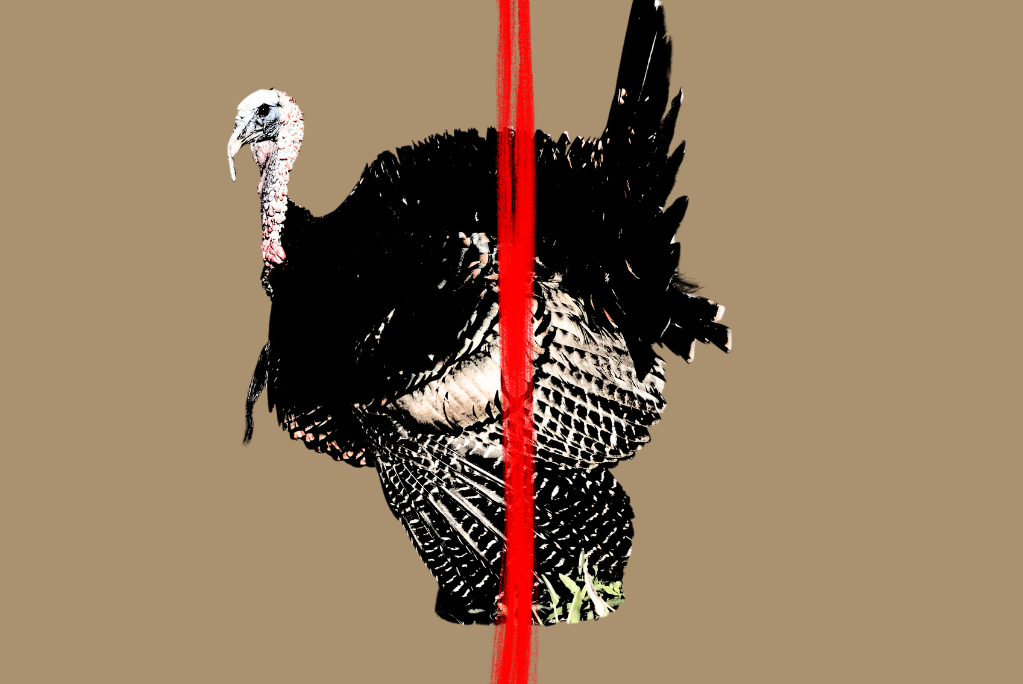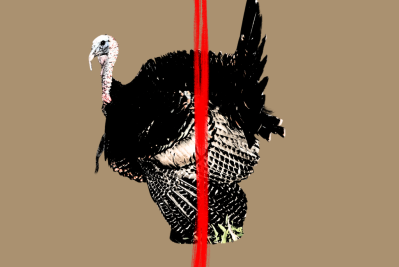When it comes to the morality of eating animal meat, human beings make many dubious distinctions. Cows make delicious steaks and burgers, but we are horrified at the thought of horse meat. Cats and dogs roam freely inside our houses, yet pigs get made into bacon. We wag our fingers at our whaling ancestors but hungrily consume tuna salad sandwiches. Even people who care deeply about the plight of animals put aside their moral qualms when presented with a plate of chicken wings and a slice of meat lover’s pizza.
For those uneasy about eating meat but unable to do away with it, a new book by philosopher Peter Singer will cause even more discomfort. Consider the Turkey might only span 82 pages of text (and an additional 19 of “recipes for ethical feasting”), but it adds up to a brief yet damning indictment of the turkey-producing industry.
Consider the turkeys’ weight. Domesticated turkeys weigh an average of 30 pounds, up from less than 17 pounds in 1960. The increase over the past 50 years is the result of breeding the birds selectively to provide ever-hungrier Americans with ever-plumper turkey breasts. As you might imagine, this ballooning weight is not good for the turkeys. Singer notes that the abnormally heavy turkeys “are in pain for the last third of their lives—a situation that has been compared with forcing someone with arthritis in their legs to stand up all day long.”
Even being able to stand at all may be a luxury for many of these unfortunate birds, most of whom are raised in the spatial equivalent of a prison camp. In 2022, 257 million turkeys were produced in the United States; of those, almost 230 million were raised in facilities that produced at least 66,000 turkeys annually. Moreover, most domesticated turkeys are given just 2 to 3 square feet to roam about. This extreme confinement causes much strife among the turkeys, who often fight one another and occasionally eat the victims’ carcasses. To mitigate the damage of such assaults, turkey producers shear off the edges of the turkeys’ beaks and talons.
Luckily for these confined, crippled, and unhappy birds, domesticated turkeys don’t live very long. After birth, turkeys are separated by sex and then slaughtered after just 11 to 18 weeks. And that’s assuming there is no “depopulation”—a euphemism used to conceal the horror of the mass culling of flu-ridden turkeys. Singer reports that when just a few turkeys on a farm test positive for bird flu, all the turkeys on that farm are killed by herding them into one room, cutting off all ventilation, and raising the temperature of the room to over 100 degrees. This process—which Singer argues is used in part because of misguided regulations and a lack of public pressure to use more humane methods—kills most of the turkeys within three hours. The few survivors are killed with a bolt gun.
Throughout Consider the Turkey, Singer makes a compelling case that the turkey, of all animals, is worthy of our pity, which might seem odd at first. It doesn’t seem like a natural candidate for garnering the sympathies of hungry humans, with its elongated neck, sharp beak, and beady eyes. These awkward traits—plus the fact that turkeys are mostly flightless—make Benjamin Franklin’s favorable comparison of the turkey to the majestic bald eagle a bit of a head-scratcher.
But Singer’s decision to pick this unglamorous bird as his subject is what makes his book so persuasive. He could have chosen to profile the pig or the cow, two animals with enough intelligence and gentleness to make many a meat eater uncomfortable. But by detailing the plight of the turkey, Singer reminds us that even the lowliest of animals deserves our compassion.
He does this in part by charging readers to consider a hypothetical in which dogs were raised, slaughtered, and eaten as turkeys are. Then he writes:
If, as I hope and expect, you would be appalled by such an industry, would boycott its products, would vote for politicians who pledged to abolish it, and would never, ever sit around a table at which the carcass of one of these dogs was carved up and eaten, then you should not act any differently with regard to the existing US turkey industry. Turkeys and dogs are not the same, but they are both capable of living enjoyable and relatively pain-free lives for several years.
I read Consider the Turkey with my cats curled up beside me, which made for a disconcerting study in contrasts. My cats are pampered and cuddled and played with and loved. When I drive home for Thanksgiving, they will catch a ride in the backseat of my car and will be showered with affection by my relatives. But do my cats truly deserve such a better life than that of the turkey I’ll tuck into on Thanksgiving? Are they that much more deserving of love than the thousands of turkeys who are cooped up, artificially inseminated, and indiscriminately slaughtered? If the answer is no, then I am left with one of two logical options: treat turkeys like I treat my cats or treat my cats like turkeys are treated.
But logic does not always win out. When Thanksgiving rolls around, despite being largely convinced by Singer’s arguments (and despite my distaste for turkey breast, which is invariably dry even with the accompanying gravy), I will undoubtedly eat turkey. Still, I can credit Singer with forcing me to confront my own ethical inconsistencies and saddling me with guilt. In that respect, at least, he succeeded.






Please note that we at The Dispatch hold ourselves, our work, and our commenters to a higher standard than other places on the internet. We welcome comments that foster genuine debate or discussion—including comments critical of us or our work—but responses that include ad hominem attacks on fellow Dispatch members or are intended to stoke fear and anger may be moderated.
With your membership, you only have the ability to comment on The Morning Dispatch articles. Consider upgrading to join the conversation everywhere.